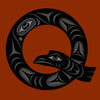Antique Basketry Bowl with Handle, Klickitat
Regular price
$800.00
Sale
Basketry Bowl with Handle, c. 1920
Klickitat Basketry
cedar root, bear grass imbrication (design), natural dyes
6.25” high (with handle) x 7.25” diameter
The Klickitat are a Native American tribe who’s traditional territory was north of the Columbia River in present day Klickitat, Skamania, and west-central Clark Counties in Washington State. The various peoples who lived along the Columbia River are famous for making baskets. The materials for making baskets—cedar and spruce roots; elk and rye grass; strips of willow, cedar, and alder bark; and Indian hemp—were usually gathered in the fall. Baskets were then woven during the winter.”
“Basketry is an art form that reached great heights of creative expression among the people of the Columbia River region. Although baskets served primarily functional purposes, they were nevertheless constructed with great care and decorated with sophisticated designs that lent them an aesthetic status beyond mere utilitarian objects.”
“Numerous and time-consuming steps went into the making of a basket, and the art of basketry was passed down from one generation to the next, with young women learning from a more experienced female relative, such as a mother, grandmother or aunt.”
Bill Mercer, Former Curator of Native American Art at the Portland Art Museum
Excerpt from his book People of the River: Native Arts of the Oregon Territory
“We call ourselves Xwalxwaypam (Whash-why-pum) and have always been a tribe. We are known to other Indians as Lataxat or by the white men as Klickitat, the name of our mountain range and river."
“All women in my tribe knew how to make baskets. At first, a young girl was not very good, but she practiced until the baskets she made were as pretty as her mother’s or even her grandmother’s...The most common designs that we used were salmon gill, trail of the eel, geese in flight, a mountain butte, and sturgeon..."
"Different basket makers in a tribe, and different tribes, used their own designs. In some designs there was meaning. A design was an inspiration, from spiritual feelings the basket maker had about a basket....designs also could be made specifically for the person who would receive the basket: flowers for women, deer for men, or what that person was recognized as doing well, such as fishing or hunting."
"The (traditional art of basket making) was almost forgotten because of cultural changes between the generations. As time went on, these cultural changes lost their effect and today our people are again practicing some of the traditions from their heritage.”
Marie Slockish (1911-1985), Klickitat Basket Maker
Excerpt from The Heritage of Klickitat Basketry: A HIstory and Art Preserved






